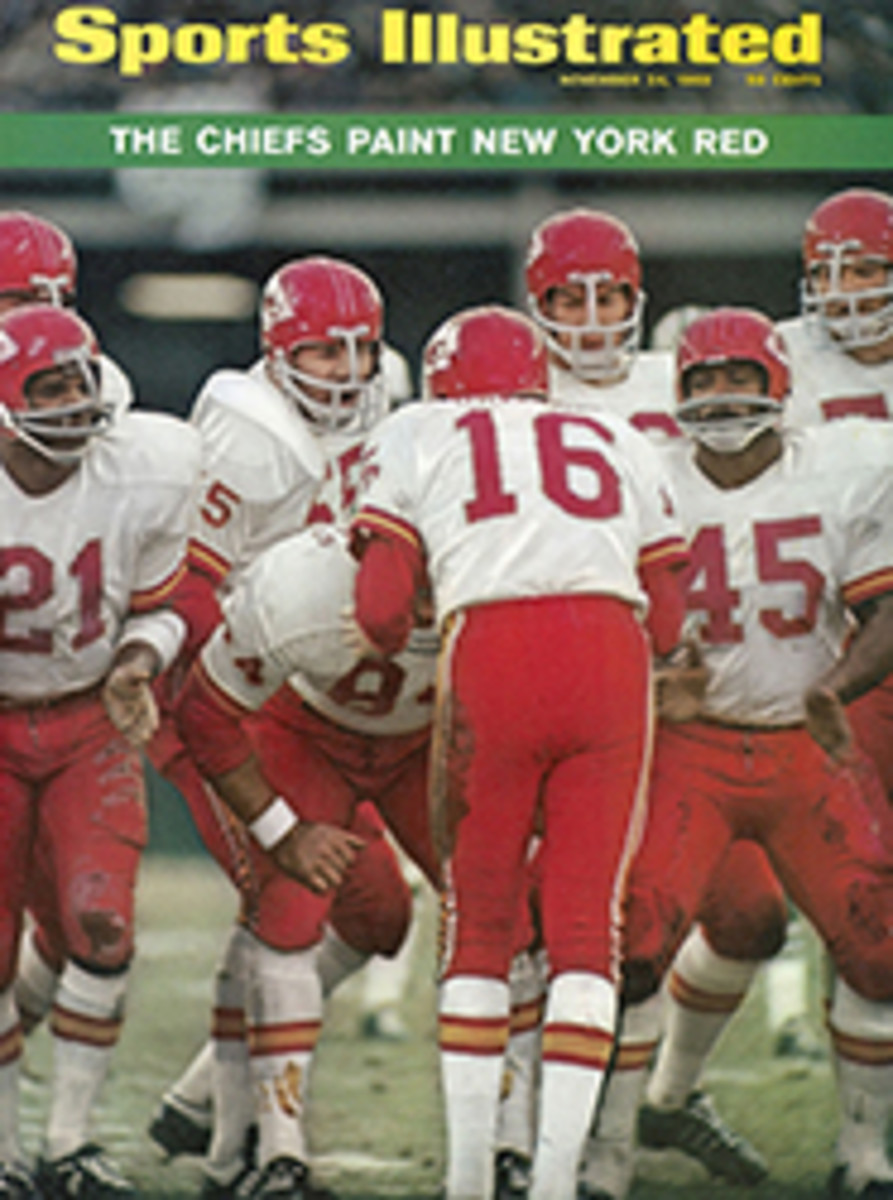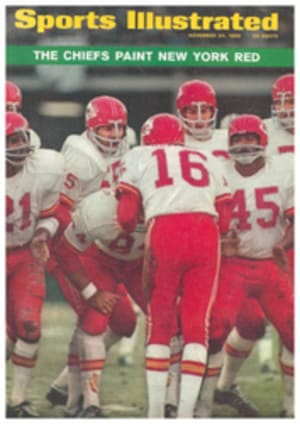
KC HAD THE HOT HAND
When it comes to camouflage, the Viet Cong are a bunch of taxis-quadders compared to Coach Hank Stram and his Kansas City Chiefs. Stram is the Doge of Deception, the Cagliostro, if you will, of Confusion, the Maestro of the Mask as it is currently worn in the world of pro football formations. And nowhere was the murky art more evident than in Shea Stadium last Sunday as Kansas City bedazzled the world champion New York Jets 34-16.
On the Chiefs' very first play from scrimmage, following a Jets fumble on their very first play from scrimmage, Stram unveiled a brand-new formation—the 31st in a series originating with his Tight-End I—and it clicked for an 18-yard touchdown pass, Len Dawson to Otis Taylor. The formation was so new that it sounded like some bizarre prototype on the drawing boards of Detroit: the GT Slot. Some players—and Stram himself—insisted on calling it the Camouflage Slot, but GT sounds jazzier, so let it thus be known. To implement it, Dawson put one wide receiver, the crafty Taylor, into a slot between guard and tackle on the right (GT—get it?). Tight End Fred Arbanas, the one-eyed wizard, lined up on the left, with Gloster Richardson way outboard of him. At the snap, utter confusion in the Jet secondary. And, admittedly, a bit among the Chiefs.
"I didn't think I was the primary receiver on that play," said Taylor. "It didn't really matter. Freddy and Gloster were both clear, too. I stepped out a bit and then angled left and I didn't even know Lenny was throwing to me. He was looking right and under a hard rush. Then he just kind of flung the ball to the left, and I had to run mighty hard to get there."
It was the first of three touchdowns for Taylor, of four for the Chiefs. And the third also came by way of a brand-new play, a wing reverse by substitute Running Back Warren McVea that gained 21 yards and helped set up McVea's two-yard scoring run four plays later. McVea—who gained 102 yards rushing—is known to his colleagues as Motor Mouse, and Taylor—96 yards on seven catches—as Slug. Between them they slugged a few mice onto the Jets' collective countenance. With a little help from their friends in the red pants, that is.
Stram's game plan was to run over the Jet tackles and pass at the corner-backs, where the Jets are weakest. Dawson soon discovered that neither Mike Garrett nor Bobby Holmes could squeeze through the cracks forced by the Chiefs' mountainous line. Earlier in the season the runty running backs—both are 5'9", though Holmes weighs an astonishing 220—had been able to use the masking bulk of their blockers to get loose. Not against New York.
So Dawson turned to the pass. He hit Garrett for 25 yards, then Taylor for 16—both on the corners—Taylor practically stuffing Jet Cornerback Cornell Gordon into the sideline seats, but in the process he aggravated the abdominal muscle pull that had kept him out of three full games. It wasn't serious, though, and Taylor would be back for more.
Stopped at the Jet 14, the Chiefs turned to the kick, namely Kicker Jan Stenerud, Norway's answer to Supertoe Jim Turner of New York. Stenerud made it 10-0. Then the Jets struck back. With Maynard and George Sauer wiggling nicely and Cornerback John Dockery redeeming a Snell fumble with a 28-yard interception, the Jets got into Turner country, and The Tank kicked a field goal from the 10-yard line. A bit of back-and-forth and Joe Namath was on the move. Maynard burned Jim Marsalis, the kid who had given him so much grief with grabby coverage in the College All-Star Game, and finally Broadway uncorked a perfect 40-yarder to Sauer over Cornerback Emmitt Thomas to tie the game at 10-10.
Then the grim deceivers took over, this time for keeps, Dawson moving them 81 yards in a dozen plays for the go-ahead touchdown. It came on another bit of Kansas City razzle-dazzle. With second and three on the Jet seven-yard line, Dawson sent Arbanas into position for a lag pass. Until then Arbanas had been holding for a couple of counts before drifting outside in the direction of Cornell Gordon. This time Gordon, whose main responsibility was Taylor, waited for Arbanas, but he didn't show. By the time Gordon had diagnosed the play, Taylor had slipped into the end zone and was two steps ahead of him. Although Dawson was about to be inundated by a green Jet wave, he got off the pass to Taylor. It looked like a busted play, but maybe—probably—it wasn't. Stram wouldn't say, and as Taylor explained: "Man, you want to sow confusion."
The closing minutes of the first half sealed the Jets' fate. Dawson once again moved the Chiefs into field-goal range, and Stenerud kicked his ninth straight from the 38—one more and he ties Dennis Partee's AFL record. It was now 20-10 Chiefs and less than a minute left in the half. The Chiefs have a way of going into the locker room with a fresh score to keep them happy during the great half-time show, but it suddenly looked like it would be the Jets who would be celebrating. Boozer slammed out of a left-side trap and raced 50 yards before he was dropped on the Chief's 21. Twenty seconds left, Willie White-shoes has his arm cocked, Tight End Pete Lammons is clearing for the end zone. But Johnny Robinson intercepts and the half ends with the Jets down by 10.
One supposed that the Jets could have emerged from the intermission all fired up. but one didn't really believe it. With the first series after the second-half kick-off it was clear which was the better team this cold, bright afternoon before an AFL record crowd of 63,849. Dawson found his running key with the McVea sweep, he found his receivers open often enough, and after 68 yards in 12 plays he had a 27-10 lead on McVea's touchdown run. The score seemed almost anticlimactic, as did Namath's second touchdown pass, a nifty number that found Maynard clear in a corner of the end zone. Jerry Mays, the Chiefs' defensive end, remembers hitting Namath's throwing shoulder with a forearm just as the ball was thrown. "I hit him pow, like that," said Mays, "but his hand kept right on coming, up past my mask and past my ear, and he hit Maynard. Heck of a guy, Namath. Once when I dropped him, he said, 'Boy, that hurt.' I helped him to his feet."
And that's the Chiefs for you—deceptive even in their manners. Big and hard-hitting, they can also be gentlemen. But can they win the big ones? By the evidence—the '67 Super Bowl, last year's AFL West playoff—maybe not.
But what too many people fail to recognize is that the Chiefs are a team in the process of rebuilding, a fact that makes their performance to date doubly impressive. As Stram points out, with an understandable touch of pride, only four of his defensive regulars started in the 1967 Super Bowl. Clearly, Stram is a superlative trader and drafter, as well as a hard-driving, innovative coach. Witness his defensive secondary: Jim Kearney, a so-so cornerback released by Philadelphia and converted by Stram into a strong strong safety; Marsalis, the No. 1 draft choice from Tennessee State who fits into the silent intercommunications of the defense like a veteran; Emmitt Thomas, the other corner, a free agent from Bishop (which is a small college in Dallas), who has supplanted Goldie Sellers; Johnny Robinson, the free safety, who with his speed and savvy provides the continuity—indeed, the spirit—of Stram's defensive backfield.
Two other trades serve to underscore Stram's canniness. He picked up Tackle Curley Culp from Denver and plugged him into the already impressive front four. Culp was an NCAA wrestling champion at Arizona State and combines that talent with sound football sense in his clever, grappling pass rush. The other smart trade was on offense. Stram, blessed with the accurate toe of Stenerud, dealt his other soccer-style kicker, Horst Muhlmann of West Germany (along with a fourth-round draft choice), to Cincinnati for McVea. The diminutive (he's 5'9", too) and cantankerous McVea had been used by Paul Brown at flanker, but Stram chose to employ him at his first love: running back. McVea, who shaves his head to enhance his bulletlike image, has the speed the Chiefs have heretofore lacked—he turns the 40 in 4.2.
Working for Stram can be rugged. A stickler for fitness, he has festooned the walls of his practice field with inspirational graffiti. One reads:
UGLY FAT...
YOU can't be FAT...
...and FAST, too.
FAT IS HARD TO SEE, FAT IS HARD TO DETECT, IT HIDES UNDER THICK SKIN, IT ENSLAVES AND SLOWS THE WHOLE BODY, AN UNTRAINED EYE CANNOT FIND FAT.
LIFT
RUN
DIET
WORK
And if you don't, Chiefling, then Stram will fine you $50 a pound. One Chief who learned about fat the hard way is Willie Lanier, the All-League middle linebacker. Now he nibbles salads for lunch with the dyspeptic disgruntlement of a matron at the Golden Door. His teammates used to call him Contact for his brutal tackling, usually effected with his head. Then, in a game last year against the Chargers, Lanier found himself tackling two John Hadls instead of one. He missed them both—the double vision being the result of a mild concussion acquired in earlier tackles. Now Lanier uses his bowling-ball shoulders and thick upper body in his tackling, and his buddies call him Honey Bear. Concussion or no, Lanier has one of the finest signal-calling heads in football defense; he is that anomaly, a black middle linebacker.
There is no racial friction on the Chiefs. "We're almost weirdly compatible," says Mays, the white Christian athlete from Texas. "The ratio of black to white is 8-3 on defense, and we have nothing but mutual admiration for one another. There's a strange sort of confidence evident here—a poise that we never had before. Last year you could feel it on its way to happening, and now we finally have the talent to match the earlier effort."
Fittingly, perhaps, it was Lanier who really ended any Jet hopes for a last-minute comeback Sunday. Namath had moved the ball down to the Chiefs' 10-yard line with a shade more than two minutes left. Sure, it was 34-16, but Namath's Namath, and the odds—at least to a diehard—weren't insuperable. Joe Willie sent Sauer out on a curl to the inside. Good call—it was third and half a yard for the first down. Who would have thought Joe would pass? Well, Willie Lanier, for one. He called a zone and, when Namath's pass popped out of Sauer's hands, Lanier was there to snatch it away. The Honey Bear gallumphed 44 yards, and that was it for New York.
"That was a storm situation," recalled Right Linebacker Jimmy Lynch after the game, "and anyone else would have played it against the run. But Willie went to the zone because he sort of read Namath. A team is always testing its own strength, and this game gave us a chance to see how good we really are. Believe me, New York was ready to test us. I figure we passed."
Said Lanier: "Man, I thought I could have gone all the way, but I just plain ran out of gas. I guess I need a few more salads and a little less ugly fat. Haw, haw, haw."
PHOTO
NEIL LEIFER
Namath tried to warm up with a new gimmick—"self-heating" mittens—but no dice.
TWO PHOTOS
NEIL LEIFER
Len Dawson who hit on 23 of 38 passes, sets up for one, possibly to Robert Holmes (45). Otis Taylor (below, being tackled by John Dockery) caught three for touchdowns.

